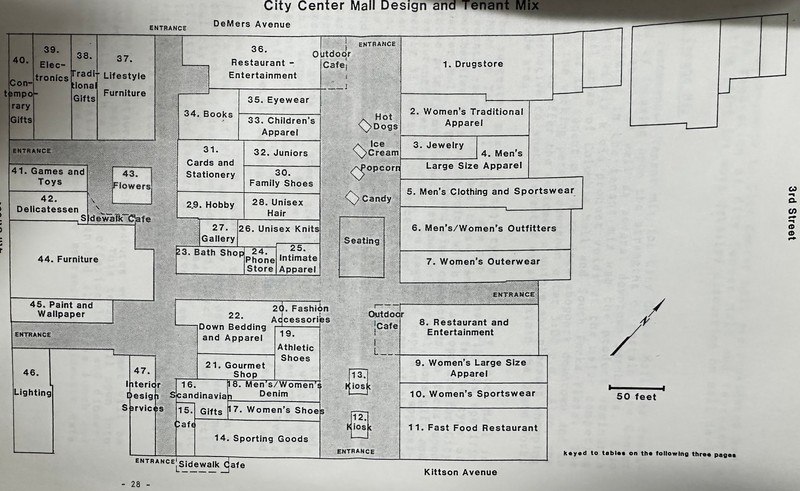The City Center Mall
Introduction
Text-to-speech Audio
The City Center Mall was a quick attempt to create an area that would attract people and encourage them to stay in the downtown area of Grand Forks. Construction finished in 1978, and the Mall was full of trendy stores then. Costing $3.1 million or $22 million in today's money, the Mall was a much cheaper construction as they added a roof over the street connecting existing buildings.
Images
blue print for the mall

Backstory and Context
Text-to-speech Audio
The first covered shopping mall in North Dakota was South Forks Plaza (now Grand Cities Mall, sometimes known locally as the "old Kmart mall"). At the intersection of South Washington Street and 17th Avenue South, it was constructed in 1964 when Grand Forks housing complexes expanded southward. Shopping centers were shifting from downtown districts to the suburbs in cities nationwide at the time, and Grand Forks saw a similar trend, albeit on a small-town scale.
The City Center Mall was a project made to try and keep the people of Grand Forks downtown so the economy would grow. The Mall was a cheap way for the city to build something to keep the people downtown and not expand out. The proposal to the mayor was very intriguing because the costs were so low, and the projections of income and popularity were so high.
However, during the same year, the Columbia Mall in South Grand Forks was also built and was a whole new building more resembling the malls we know today. It was bigger and had more major department stores than people were accustomed to in the 1970s. Even though the City Center Mall did have a few department stores, they were smaller than the new ones in Columbia. With greater access to the newly completed Interstate 29, the Columbia Mall was built even farther south near 32nd Ave. South when it in 1977. Therefore, it makes sense that downtown businesses were concerned. JCPenney relocated to the Columbia Mall from its previous home on South 3rd Street in the heart of downtown. Business owners in the downtown area feared their enclosed malls would steal all their customers. They decided to enclose a block of South 3rd Street and transform it into an enclosed mall.
The City Center Mall did not meet the planners' expectations and did not improve many businesses downtown, however. For many reasons, the Mall did not succeed; for example, the Columbia Mall was in many ways better and was attracting people there, but the already in-motion trend of the people of Grand Forks moving out of downtown to more significant pieces of land and the rush of the project that made the Mall uninviting to guests.
Then, unfortunately, the great flood of 1997 hit Grand Forks, and the Mall was destroyed like many other buildings downtown. With the Mall being close to the river and most of the Mall on ground level, most things could not be salvaged. Due to the minor success of the Mall, the town decided to scrap the Mall and return the street to how it was and return the business to what they formally were.
Today walking where the Mall once was, there are few indications that there even was a mall there. The covered street, 3rd Street, is back to once it was with cars and parking. However, where there once was one of the entrances to the Mall now sits Loon Park. A park was built between buildings that once held businesses in the City Center Mall.
Sources
Grand Forks City Center Mall Records. OGLMC 1446, Box #, Folder #. Elwyn B. Robinson Department of Special Collections, Chester Fritz Library, University of North Dakota, Grand Forks.
Grand Forks City Center Mall Records. OGLMC 1446, Box #, Folder #. Elwyn B. Robinson Department of Special Collections, Chester Fritz Library, University of North Dakota, Grand Forks.
